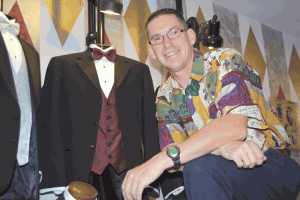
Doing Business In: West Springfield
West Side’s Story Is One of Access and Diversity

When it came time to launch his own business, Kevin Kousch says, it made good sense for him to stay in West Springfield.
He’s the owner of A Formal Affair, what he calls the “largest in-stock tuxedo rental this side of Boston,” and you might remember him from his days with the now-defunct clothier Yale Genton, also in West Springfield. Kousch was referring to the challenging circumstances facing everyone in business, and how his venture has wholeheartedly embraced new media, as well as good old-fashioned word of mouth, to secure a place as a go-to, top-of-the-line formalwear outfitter for the area.
In many ways, his comments were echoed by other business owners in this town, long a commercial destination for many in the region, due to the popular and thriving Riverdale Street thoroughfare. Cindy Johnson, owner of Fran Johnson’s Golf and Tennis along that strip, said that, since her much-publicized economic difficulties and comeback in 2010, she’s taken some creative steps to broaden the seasonal nature of her store’s offerings.
“It’s what you have to do in order to stay afloat,” she said, while describing an exciting new way for her customers to enjoy the game of golf — simulators that enable someone to play Pebble Beach without leaving the 413 area code.
But while there are businesses in town that are readily embracing new techniques to stay vital in a challenging economic time, there is one signature venue in West Springfield that believes it’s also important to keep in mind the past, and how history, specifically with regard to agriculture, is a key link to the future.
And where else could an agrarian industry be better represented than at the 17-day Eastern States Exposition, the Big E, held every September for almost 100 years along the town’s Memorial Avenue? Wayne McCary has been president of the Big E since 1991, and he told BusinessWest that “I think it’s important to know that we will continue to make sure that agriculture remains a part of this facility’s soul.”
With annual visitors to both the Big E and other events at the site totaling more than 2 million individuals, he also stressed the importance of the facility’s power to be an important agent for West Springfield, for both the town itself and the business community.
Go with the Flow
When asked what was happening in his office these days, Joseph Laplante, West Springfield’s Community Development director, said, “quite a bit, actually.”
The big news these days is forward momentum at the West Springfield Trade Center, a 5.750-acre parcel along Western Avenue that the town has been working on for several years. The property is adjacent to the CSX rail yards, said Laplante, adding that the town has just finished demolition and cleanup at the property, and now the redevelopment authority can proceed with a marketing plan.
An attractive aspect of the site is that proximity to CSX, which is also putting steam to a $10 million expansion and upgrade of its West Side yards, LaPlante continued, adding that the plan is to attract a new business, preferably in manufacturing, that will create new employment and a new tax base for the community.
“We’re trying to avoid, more or less, a warehousing operation, which doesn’t bring many new jobs in,” he said.
Additionally, he mentioned a project currently in the design phase to improve clearance at a railway underpass along Union Street, which will significantly impact larger tractor-trailer traffic flow to the south side of town, “which doesn’t exist right now.”
That $15 million project, with an estimated completion date in 10 years, will improve load-heavy traffic flow outside of the historic city center and some of the residential neighborhoods in town. But, he added, not all the good news is years away.
Some signs of economic recovery are coming from large stores along Route 5 that are in remodeling stages — Kohl’s, Dick’s Sporting Goods, and the Stop & Shop, all in the Riverdale Shops. And near that plaza, construction of a town canoe ramp this spring will offer visitors access to the river — and increased visibility for the stores there.
“I think that people find it easy to come to West Springfield,” Laplante said, “because there is more of a small-town atmosphere, and it’s a safe and easy place to stop off and do business.”
Tailor Made
After working at Yale Genton for many years, Kousch said, it made good sense to stay in West Springfield when the time came for him to start his own business venture.
“I’ve been here for the majority of my professional career,” he explained. “When you come from a company that was in business for over 75 years, and you’ve devoted a lot of your time to the community, I don’t think it’s fair to uproot and go somewhere to start fresh where you don’t have any roots. You build relationships with people, and then, in turn, those people know that they can count on you when they need your services.”
The economy has put a dent in business, he said, adding quickly that he is confident in his strategies for keeping both his business and his clientele in the black — quite literally.
“Every customer here is custom-fit,” he said. “And because all of our stock is right here, we don’t deal with any of the issues that the competition does, where they have to get their merchandise from a warehouse and then try to navigate any complications.”
Solid word-of-mouth referrals are a key part of Kousch’s marketing strategy, but embracing Facebook and e-mail-blast advertising help keep a company on point. “You have to be with the times for a business to succeed,” he continued.
And as prom season approaches, Kousch said that he was employing another strategy for success — lowering his prices for 2011. “It doesn’t do me any good to have the stock sitting here on hangers; we’d rather rent it.” His old sign from Yale Genton — and those historic prices — are right out in front of his shop.
For those folks who might ‘like’ AFA on Facebook as they consider who will be their prom date this spring, he added, “there’s going to be lots of specials starting in mid-April; we’re expecting to be very, very busy.”
That’s something that Cindy Johnson is also happy to report.
She said the new Tee2Green2 high-definition golf simulators that Fran Johnson’s purchased last November represent a “welcome opportunity to be busy during the winter months, which is a first for me in about 30 years.”
Using these high tech video displays, customers can choose to ‘play’ 18 classic courses, from Pebble Beach to Casa de Campo. “They use their own clubs, play with real golf balls,” she said. “It’s completely different from something like PlayStation.”
While in the past, Fran Johnson’s suffered through the winter months when dedicated duffers couldn’t be on the links, the simulators have finally turned her operation into a year-round destination.
But as the area courses get ready for the approaching season, Johnson said that she’s excited to begin fitting customers for clubs — both new and used sticks. “You want to make sure your old clubs still have the right loft and lie for your swing. As with everything else, things change over the course of a few years.
“Then you can take your newly fitted clubs and try them out on the first hole at Doral,” she added.
Farmer’s Almanac

The Big E established a trust fund for the city in 1994 that has amassed more than $2.3 million to date.
“We’re fortunate to be located in West Springfield where we have built these significant bridges with people who have to play a critical role in the outcome,” he said, “especially when it comes to public services and safety.”
The Big E is one of the few fairs of its kind in the nation not heavily subsidized by state government, and as a nonprofit, he emphasized the importance of those bridges within the town.
“One of the unique things here, and I think this is a model way for a nonprofit to behave in a community, is the Big E West Springfield Trust Fund, which we created in 1994,” he explained. “It cements the relationship with people in the community, and it provides a very important revenue stream, especially in these times when municipalities and states are economically hard-pressed for resources. Through 2010, we have contributed more than $2.3 million, through 1% of our gross annual revenues.” That’s in addition to contracting the town’s services — its largest vendor, adding an additional $1.2 million to the city’s coffers.
But, he added, the Big E — as an exposition and a multi-use facility for those other 11 months of the year — is very aware of the business community nearby.
With many thousands of vendors descending on Memorial Avenue throughout the year, McCary stressed the importance of marketing West Springfield’s private sector to visitors from outside the environs.
“We encourage people to patronize business in the area,” he said, adding that “our marketing department creates a directory of local enterprises. We’re trying to channel those individuals to look into the service stream on Memorial Avenue.”
The Big E is a nonprofit, though, and McCary highlighted the importance of economic strength for the facility itself. “The other 11 months are absolutely critical to maintaining the economic stability of the exposition,” he said. “No matter how successful the fair is in 17 days, in today’s world, in order to maintain a first-class physical plant of 175 acres with more than 30 buildings, it’s a challenge.
“These year-round events contribute very significantly not only to the overall economy of the Big E, but to all the area services we’ve been talking about,” he continued. “That’s important to our own economy, and our own health, but I think it’s critical to the Big E as an economic engine; there’s no question about it.”
But the message he likes to drive home, he said, is that, since 1916, agriculture has always been the heart and soul of the Big E.
“We are an important forum to bring together young people from 4H and Future Farmers of America, who have commitments to being in the food industry for their livelihood,” McCary said. “As many as 17 states send kids here to compete in the different fields of agriculture.
“While we’re talking about economics, and how important they are,” he added, “without agriculture, none of us could continue to exist.”





